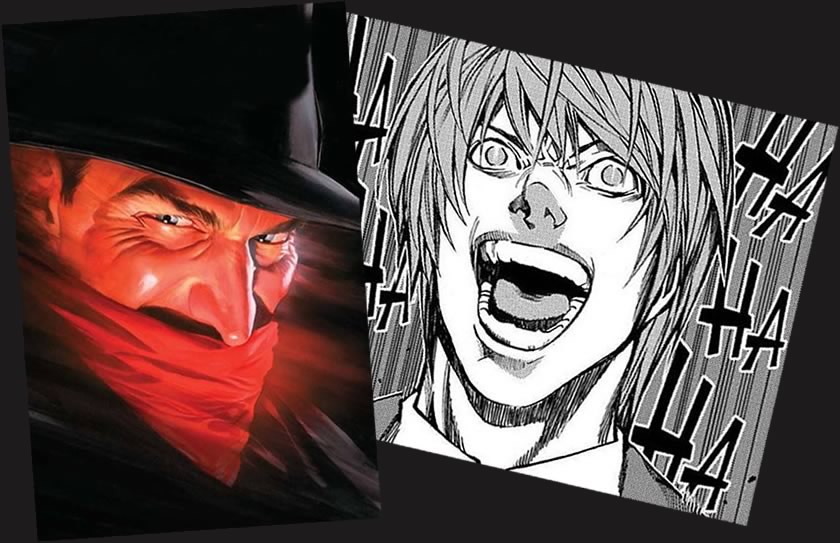

Damned knights: ranking the darkest heroes of all time
Since not all villains twirl their mustaches and rob banks, the world doesn't need all of its heroes to be boy scouts. That is the case with the heroes and anti-heroes of this issue. The darkest vigilantes of all times, face to face.
THE PUNISHER
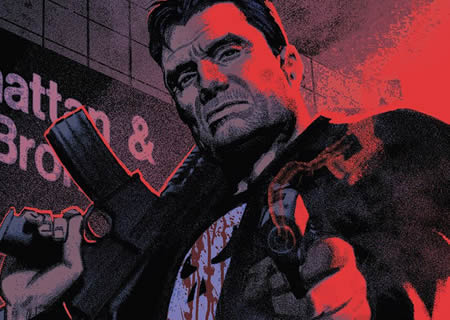 Frank Castle
Frank Castle
Because when a criminal get to see the purple of his guts shine on the sunlight before going to hell, it isn’t vengeance; its punishment.
A strong storm wakes you. It is late at night. As you reach for the light switch next to your bed, palm tree leaves frantically scratch your room’s large windows. Electricity doesn’t work. You should be worried, especially with your line of work. But you aren’t. After all, you didn’t build your mansion on one of the many small unnamed islands of the Caribbean because you like the ocean view. You did it because its practically impossible for someone to find you there.
 Verified by LinkProof
Verified by LinkProof
You get off the bed, put on your gold-embroidered slippers and drag your feet across a carpet of naked women to the bathroom. One of the girls wakes with a soft moan; you whisper her to go back to sleep while tying a knot on your purple bath robe.
In the bathroom, the water from the large fountain you paid famous Greek sculptor Konstantinos Polikronomunos to install there is warm to the touch. That’s how water is during these times of the year on the island. It helps to shake the sleep away, true, but not this time. This time it woke you into a nightmare.
In the mirror’s reflection, you see the door silently closing behind you. You also see the pale skull that’s painted on the shirt of the man that’s closing it. That damn skull, shinning in the moonlight. As if it were smiling at you. As if the damn thing was death itself, making a grimace.
You’ve been in the business long enough to know what it means when the man with the skull shirt shows up.
The Punisher needs little introduction. After the mafia murdered his family, war hero Frank Castle becomes a bloodthirsty vigilante who stops at nothing to put a cruel end to organized crime.
Renowned for the unnecessary brutal of his methods and for inspiring fear with his signature skull-shirt, Frank doesn’t nitpick who he brings in front of death. Bank robbers, assassins, mercenaries, gang members, drug dealers, even warlords; to him they are all equally deserving of the edge of his knife.
When it comes to imparting justice, The Punisher is as blind as a grenade launcher in a room full of corrupt politicians.
An extensive training in all types of weapons courtesy of the United States Marine Corps, the Marine Force Reconnaissance, the Airborne School and the Navy SEALs, along a short cross-training with the special Australian Air Service Regiment during his Vietnam tour, make of Frank a master of infiltration, military strategy, camouflage, hand-to-hand combat (comparable only to Batman’s) and in complex methods of extracting information, turning him into judge, jury and executioner of his own crusade.
Besides having his skills, Frank has counts with variety of safe houses, vehicles scattered around his main base of operations (New York City), bank accounts filled with the money of the criminals he takes down and with a handful of false identities that he forces forgers to make for him with the sole purpose of bringing the horrors of war to those who cross the line of decency.
Born from the pen of The Amazing Spider-Man’s Gerry Conway, The Punisher got his inspiration from The Executioner, a very popular pulp character from the golden age of fiction created by Don Pendelton.
Although Frank Castle and Pendelton’s Mack Bolan share similarities (both are war veterans, both become vigilantes after their families are killed by the organized crime), Frank has been in the race for much longer, which has offered him the opportunity to be developed by many talents, each adding their own inspirations to his personality.
Of the many characterizations of Frank Castle that Hollywood has taken to the cinema through the years, some of them good, most of them “okay” (let’s not discuss the cartoon), the best remains, without doubt, his first appearance in the 1989 flick titled simply “The Punisher”.
As he waits for his many injuries to heal in the darkness of the maze that the New York City sewers are, a naked Dolph Lundgren delivers shivers with which is perhaps Frank Castle’s best line on screen:
“I still talk to God sometimes, I ask him if what I’m doing is right or wrong, I’m still waiting for an answer, and until I get one, I’ll be waiting, watching, THE GUILTY WILL BE PUNISHED!”
SWAMP THING
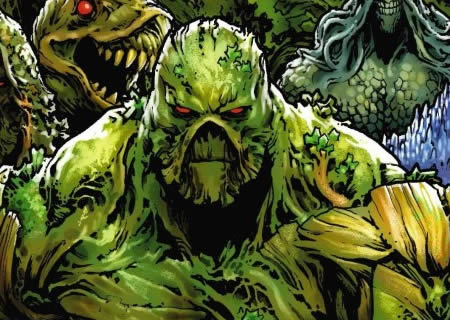 Swamp Thing
Swamp Thing
Because there isn’t a thing in the universe as cruel as nature.
Out of the depths of the Louisiana Swamps comes a man born from the fire and the chemicals of his own secret laboratory: Alec Holland, the Swamp Thing.
Although there have been several incarnations of this monstrous elemental, Alec ranges amongst the most well-known ones due to Alan Moore’s fantastic 1984’s revision where he answered the question: its the Swamp Thing Alec Holland, or the other way around?
As peaceful as mother nature —and just as ruthless— this anti-hero roams earth guarding its balance and mercilessly punishing those who dare to commit crimes against life.
With an arsenal of powers that go from regenerating its own severed limbs, up to being reborn from the ashes as a phoenix by transmitting its consciousness anywhere where there is plant life, The Swamp Thing its capable of growing wings to fly whenever he chooses, alter its shape and size, extend its arms or legs to lengths other superheroes can only dream of and most importantly, control all plant life on any planet of the universe by will.
Who in its right mind would fight such a thing? Such a Swamp Thing?
Well, who would fight an entire planet, that’s the question! Superman? Possibly, but while Superman gets his powers from the sun, Swamp Thing gets his from life itself; whether it’s from planet Earth, Venus or any other planet that supports life in the galaxy. The simple fact that Swamp Thing represents the incarnation of nature and life itself, makes it immortal, and perhaps even more powerful than the son of Krypton.
But like all of those who travel the way of the champions, this wasn’t always the case. The immortal being known as Swamp Thing showed its leaves for the first time in 1971’s House of Secrets #92, from no other than from DC Comics itself.
Back then, creators Len Wein and Bernie Wrightson had Alex Olsen (the very first Swamp Thing) getting murdered by a love rival in the 20th Century, then performing a Lazarus act when he returned from the grave as a humanoid plant-like being in thirst for revenge. A plot that would have made that Nina Wilcox Putnam, co-author of the 1937 version of the mummy, spit out the afternoon tea through of her nose.
Perhaps because there is a notorious resemblance with Mary Shelley’s lost son, who also rose up from the grave reanimated by chemicals (though many still believe electricity did the trick, due only knowing Frankenstein through all the film and television versions, as happens with the Swamp Thing), that the story became interesting enough to have caught the attention of readers everywhere.
Far from the guardian of life that we know it for today, but surprisingly similar in its vicious methods of imparting justice, the first appearance of Swamp Thing was successful enough for DC Comics to grant him his own series. From night to morning, Len and Bernie earned more time to expand on this first idea of a plant-like man returning from the grave, and boy did they used it.
Leaving behind the tuxedos and mustaches, the duo rewrote the next installation of Swamp Thing in a more contemporaneous setting, moving towards what would be fertile ground for one of the most iconic characters ever to be conceived in the history of comics.
THE SHADOW
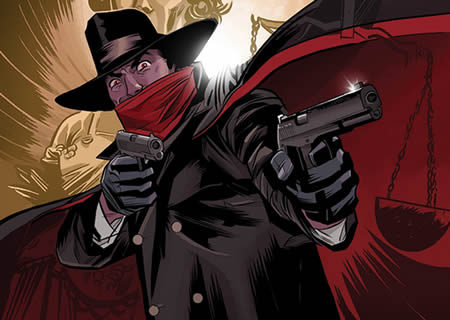 The Shadow
The Shadow
Because the forbidden knowledge to cloud men’s minds remains as one of the sinister pleasures that can be wielded only this mysterious servant of the darkness.
Famed World War I aviator, Kent Allard, returns home under the alias of Lamont Cranston, a wealthy young businessman with few worries in life, other than being a night vigilante who keeps evil at bay.
After having learned to cloak men’s minds while he traveled through the mysterious far lands of East Asia, Lamont becomes The Shadow; a terrible invisible force that dodges bullets and swiftly moves around his enemies without being seen, only heard.
His deep, cruel laugh its a characteristic signature that sheds to despair and madness the minds of those who dare to commit a crime in his city.
A master hypnotist with incredible physical abilities, unparalleled reflexes, an extraordinary marksmanship with his .45 pistols and a raw thirst for justice, makes of The Shadow one of the darkest characters ever created.
Capable of contorting his body to extremes that would make India Fakirs get a cramp, Lamont can slip through the narrowest walls, compress his lungs to hold his breath for inhuman lengths of time and even distort the very muscles of his face to hide his facial features at will.
His deep, cruel laugh its a characteristic signature that sheds to despair and madness the minds of those who dare to commit a crime in his city.
Besides being able to project his voice over great distances just as a super ventriloquist would do, Lamont fluently speaks many different languages to perfection, skillfully utilizes several styles of hand-to-hand combat with great physical prowess and possesses the power to bend the will of the criminals he faces, almost instantly, turning them into mere puppets. All thanks to his hypnotic powers and to his training in the arcane ways of Asian concentration.
Created to boost the sales of Detective Story Magazine back in glorious 30’s, The Shadow first began as an omnipresent narrator for a Tales-From-The-Crypt style radio show but featuring stories from the detective magazine. Then, as a monthly publication when listeners from all over the country began asking newsdealers for “that Shadow detective magazine” that nobody seemed to find.
Commissioned to come up with two stories per month the length of a novel, it wasn’t long until Walter B. Gibson (writing under the pen name of Maxwell Grant), had to ask other writers for help to face the challenge, although he managed to finish the impressive amount of 282 stories of The Shadow in a span of twenty years.
Besides influencing creators such as Bob Kane and Bill Finger in the creation of famous characters such as Batman or V, from V for Vendetta (Alan Moore), Gibson’s The Shadow inspired a whole generation of crime fighters detectives in the pulp magazines. They would take justice by their own hands with excessive brutality never seen before until then.
Operating from his secret facility in New York and using a network of agents that owe him their lives ranging from cab drivers, policemen, doctors, and even judges, The Shadow watches over the entire planet and puts a final answer to the question “who knows what evil lurks in the heart of men? The Shadow knows.”
MARV
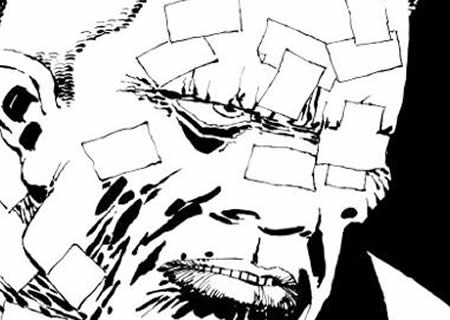 Marv
Marv
Because even when having short lives, the feats of some heroes “scream” louder than those of others.
Sin City it’s a rotten place to live. It soils everybody. One has to have the moral strength of ten men to stay straight, not to slip fall down its cracks, not to be tempted by its corruption. Marv was twenty times stronger than any man. He held his head high and remained straight, all the way until the end. Out of the “Projects”, comes a hardboiled man who never wanted to be a hero, but in Sin City, that’s the way life dealt his cards.
Unlike many others we are so used to call heroes, Marv doesn’t have an infinite supply of tech gadgets, money or -more importantly- superpowers. He doesn’t even keep watch over his city, at all. In fact, he doesn’t even think of Sin City as “his” city; he despises it for what it does to people and the only reason he sticks around its because, in his own words, he “kind of like it” there.
So how does Marv fights crime if he is not a vigilante, or belongs to a group of heroes that go around jumping roofs dressed in leggings?
Well, one thing is for sure; Marv never heard the hero’s call, he was born one. Right off the crib; a natural born hero. Instead, the question should be “what does a born hero do?” He keeps to his own and doesn’t bother the rest with delusions of greatness, which is more than we can say about many of the so-called traditional superheroes. Although somehow, troubles always seem to find him.
That said, the only thing that motivates Marv into action when those troubles come knocking is the very thing that makes him a hero; his strong civic duty and implacable sense for justice.
With almost seven foot of hard muscles, flattop buzzcut haircut scarred grim face and a mental condition that makes him dangerously psychotic, Marv is as savage as he is fair. If he crosses path with a crime being committed and can do something about it to level things up, he goes for it. The pleasure that comes from his brutal ways of fighting injustice, where those who would normally get away with crime end up crippled for life or even dead, is just an advantage that he learned to enjoy.
…the only thing that motivates Marv into action when those troubles come knocking is the very thing that makes him a hero; his strong civic duty and implacable sense for justice.
Similar to a kind of “Conan the Barbarian” wearing an overcoat (according to Frank Miller’s own accounts), Marv is a formidable fighter and surprisingly skilled when it comes to weapons, despite he doesn’t have formal or military training, unlike many traditional heroes do. Instead, Marv makes use of his brutality, strength and street skills to survive Sin City.
Although Marv dies in “The Hard Goodbye”, he does it in a more than stellar way. He doesn’t fall saving the planet from an alien invasion, nor fighting to protect the entire city’s population from some caped archenemy’s evil plan. He simply kills his way up the ladder of a political-church conspiracy in the name of a dead prostitute and pays the price for it.
The way Marv rode the thunder was so magnificent, so perfect, that the famed collector’s toy line McFarlane Toys immortalized the scene by released a special version of the character in his last moments strapped to the electric chair.
Buyers of the figure can pass electric current to Marv as many times as they wish and get in return the most sincere and emotionally charged last words ever to have been printed in the world of comic books.
Last words so powerful, so full of darkness, that managed to elevate his creator, Frank Miller, above all of the other writers in the industry, inviting him to take his place along talents such as those of William Shakespeare, Walter Whitman, and Edgar Allan Poe.
- “Is that the best you can do, you pansies?” Sheer poetry.
KIRA
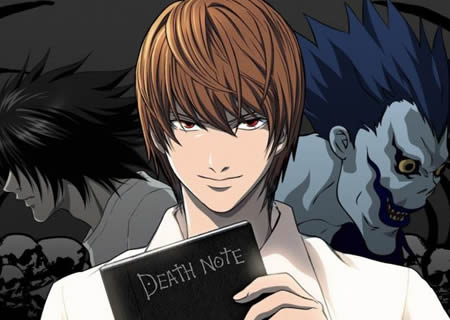 Kira Death Note
Kira Death Note
Because few things in life are as dark as the soul of a teenager with a god of death as a pet.
Up to a point, it might be said that Light Yagami is the luckiest of all heroes on the list. He has it all; youth, good looks, academic success, a loving family and a bright future ahead of him.
So why someone like him would adopt a secret identity and start chasing criminals? The answer might not come as a surprise, for it is guilty of having driven most teenagers to do unthinkable things throughout history: he does it out of sheer and simple boredom.
Upon finding a Death Note in the schoolyard, Light Yagami starts a strange partnership with Ryuk, a Shinigami (or god of death) that has grown frustrated with the rules of life and death and has decided to come up with some of his own.
After carefully studying the rules laid by the deity on the notebook, Light Yagami adopts the name of Kira, a severe invisible hand that brings justice to criminals everywhere in the world.
Though Kira doesn’t have any powers of his own other than his smarts, he might be considered the most dangerous hero on the list. And yes, he is a hero, but more on that later.
While the most important rules that govern the Death Note are only five, to be completely aware of its true power and wield it for as long as he did, Kira had to memorize more than fifty, surprising even the Shinigami itself.
Suffice to say that these rules are not only complex but interconnected to each other, making the Death Note a deadly trap to whoever uses it. Proof that Light Yagami’s wits are as sharp and as powerful as any weapon or learned a skill by other heroes.
By simply writing the name of his victim in the notebook and concentrating on its face, Kira is able to kill from anywhere in the world and get away with it. He can even go as far as to describe the “how” and “when” as detailed as he fancies; which gives him full control on the person’s death in ways no other hero on the list has.
The fact that he does while living under the same roof as the murder’s main investigator (his father) would be admirable enough, but Kira takes it one step further by participating in the investigation himself. Soon, he takes down every criminal in the FBI most wanted list like if they were nothing, then he goes on to try to get rid of every criminal in the world, all while having lunch with those who are in charge of capturing him.
Over time, as people begin to worship the invisible hand that terrorizes those who break the law, Kira becomes a deity on his own right.
Though the Manga and Anime paint him as a cocky brat with a thirst of power, Kira, turns out, is nothing short of the ultimate hero.
With everything to lose and nothing to gain, he unleashes a killing spree that lasts long enough to do what many heroes the size of Batman or Superman can only dream; change the world. With Kira, criminals everywhere went from abusing the system to escape punishment, to fear it.
Despite his obvious intentions to bring true justice to the world, the “hero” of the series is not Kira, but a Sherlock Holmes knock-off named “L”. Every police organization in existence and even his own father, head of the Japanese Task Force, mount an unprecedented manhunt in an attempt to try to capture him.
With no other allies than the Shinigami’s own sick desire to see mayhem, his demented girlfriend, and his own intellectual capacity, Kira manages to beat all odds and, ultimately, give a bloody battle against crime.
